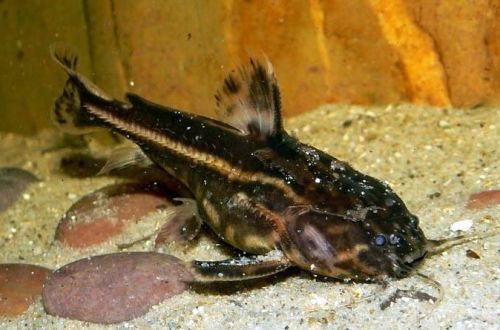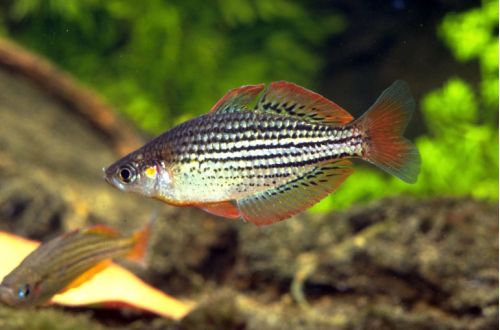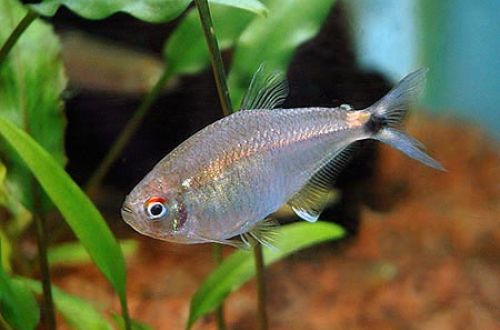
Danio Rerio (albino)
Danio rerio albino, scientific name Danio rerio, belongs to the Cyprinidae family. The fish is a natural morphological form of Danio Rerio, found in the wild, the only difference from a congener is the absence of pigmentation, from which the stripes on the body are not dark, but white. Active and peaceful fish, able to decorate any tropical aquarium. A special flavor is achieved when kept together with the classic Danio rerio.

Habitat
Danio rerio was first described by the explorer Hamilton in 1822, found in Asia from Pakistan to India. Danio albino is a natural morphological form that lives in the wild and has been successfully adapted for aquariums.
The fish lives in the channels of rivers and ponds, during the rainy season, as meadows are flooded, in rural areas – rice fields, Danio moves to these temporary reservoirs, where they lay eggs, and then return back. Prefers clean running water, shady places with dense vegetation.
Requirements and conditions:
- The volume of the aquarium – from 40 liters.
- Temperature – 18-24°C
- Value pH — 6.0–8.0
- Water hardness – soft to medium hard (5-19 dH)
- Substrate type – sand or fine gravel
- Lighting – moderate
- Brackish water – no
- Water movement – moderate
- Size – up to 6 cm.
- Meals – any
- Life expectancy – from 3-4 years
Description

Danio rerio albino has a slender compressed body no more than 6 cm long, in large tanks, for example, in ponds, they can grow a little more. There are subspecies of Danio with small antennae at the end of each lip. Life expectancy reaches 4 years. The fish has a light creamy coloration with white stripes running from head to tail.
Food
In a home aquarium, fish will happily consume all types of dry commercial food. The main condition is that the food should be floating on the surface of the water. Live or freeze-dried food is able to diversify the diet – brine shrimp, bloodworms, mosquito larvae, etc. Feeding is carried out 2-3 times a day in portions that the fish can eat in 3 minutes.
Maintenance and care
Fish does not require special conditions, withstands changes in water hardness and pH levels. Water should be clean, without noticeable suspension. Due to the fact that fish are kept in small aquariums from 40 liters, in order to avoid elevated concentrations of nitrates and phosphates, the water should be replaced once a month by 50%. The ability to live at a low temperature eliminates the need for an aquarium heating system. The fish is able to jump out, provide a cover for the aquarium.
Danio spends most of the time in the upper and middle water levels, requires sufficient space for swimming and shelters in the form of thickets of plants, which should be located along the side and rear walls of the tank. Lighting is moderate, bright light will make the color of the fish pale and will cause unnecessary discomfort. As a substrate, preference should be given to sand or fine gravel of a dark color.
Social behavior
Peaceful accommodating fish, belongs to schooling species, it is recommended to keep at least 5 individuals. They lead an active lifestyle, so it is better to choose neighbors in the aquarium with a similar temperament, sluggish fish can be disturbing. Should not be kept together with large or predatory fish, zebrafish can be their first meal.
Breeding / breeding
Females are noticeably larger than males, which are more graceful in shape. Two fish, as a rule, form a pair, which lasts throughout life. Breeding is recommended to be carried out in a separate tank, in which the substrate is laid out from 1–2 cm balls, or similar sized pebbles. First, the female is launched into the tank, the next day the male. The stimulus to start spawning is the addition of a few glasses of cold water – an imitation of the rainy season. The female releases eggs, which are fertilized by the male. Eggs roll between stones / balls, where the fry appear. Parents immediately after spawning are removed back to the main aquarium, as they are prone to eating their offspring.
Diseases
The fish is hardy, in optimal conditions there are no health problems, if the water quality deteriorates, Danio albino becomes vulnerable to ichthyophthyriasis. More information about diseases can be found in the section “Diseases of aquarium fish”.
Features
- They feed near the surface, the food should be floating
- Possible jumping out of the aquarium





